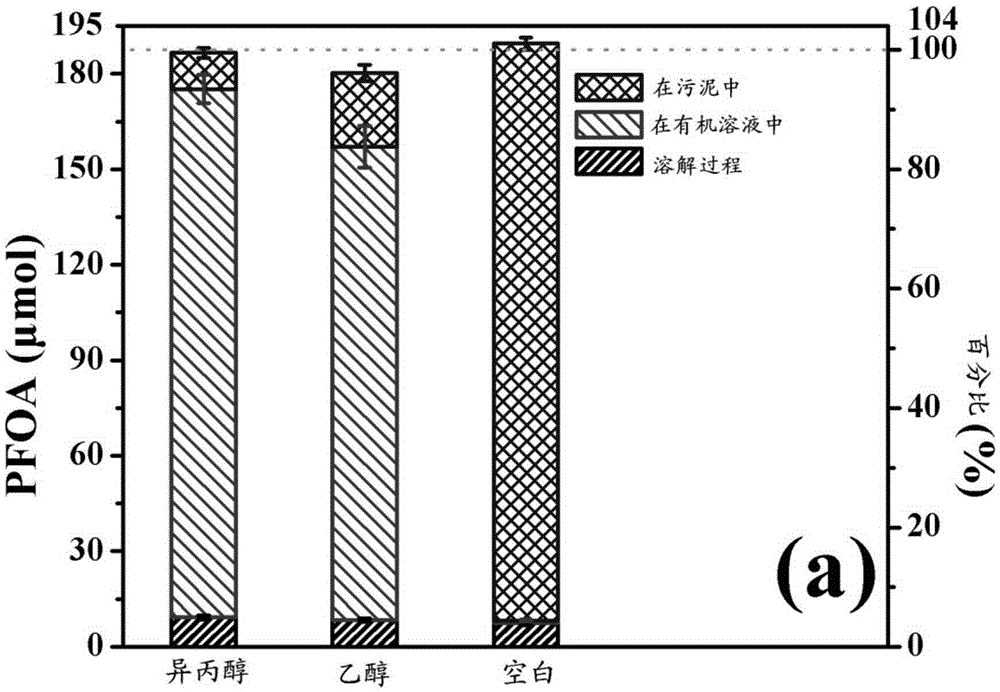Method for recovering perfluorinated compounds from sewage
A perfluorinated compound and sewage technology, applied in the field of electrochemical technology and environmental protection, can solve the problems of difficult continuous operation, secondary pollution, unfavorable environmental protection, etc., and achieves the effect of adapting to a wide range of concentrations, less sludge production, and convenient operation.
- Summary
- Abstract
- Description
- Claims
- Application Information
AI Technical Summary
Problems solved by technology
Method used
Image
Examples
Embodiment 1
[0035] Electrocoagulation treatment of solutions containing high concentrations of perfluorooctanoic acid.
[0036] Measure 500mL of perfluorooctanoic acid solution with a concentration of 200mg / L and place it in the electrolytic cell. The anode zinc plate and the cathode are titanium plates. At a current density of 10mA / cm 2 1. Under the condition that the distance between the plates is 15mm, the DC power supply is used for electrolysis at room temperature, and the sampling and analysis are carried out regularly. After 30 minutes of electrolysis reaction, the recovery rate of PFOA in the solution is above 99%.
Embodiment 2
[0038] Electrocoagulation treatment of solutions containing low concentrations of perfluorooctanoic acid.
[0039] Measure 500mL of perfluorooctanoic acid solution with a concentration of 500μg / L and place it in the electrolytic cell. The anode is made of zinc plate and the cathode is made of titanium plate. 2 1. Under the condition that the distance between the plates is 15mm, the DC power supply is used for electrolysis at room temperature, and the sampling and analysis are carried out regularly. After the electrolysis reaction for 10 minutes, the recovery rate of PFOA in the solution is over 90%.
Embodiment 3
[0041] Electrocoagulation treatment of solutions containing high concentrations of perfluorooctane sulfonic acid.
[0042] Measure 500mL of perfluorooctane sulfonic acid solution with a concentration of 200mg / L and place it in an electrolytic cell. The anode is a zinc plate and the cathode is a titanium plate. At a current density of 15mA / cm 2 1. Under the condition that the distance between the plates is 15mm, the DC power supply is used for electrolysis at room temperature, and the sampling and analysis are carried out regularly. After 30 minutes of electrolysis reaction, the recovery rate of PFOS in the solution is above 99.0%.
PUM
| Property | Measurement | Unit |
|---|---|---|
| concentration | aaaaa | aaaaa |
Abstract
Description
Claims
Application Information
 Login to View More
Login to View More - R&D
- Intellectual Property
- Life Sciences
- Materials
- Tech Scout
- Unparalleled Data Quality
- Higher Quality Content
- 60% Fewer Hallucinations
Browse by: Latest US Patents, China's latest patents, Technical Efficacy Thesaurus, Application Domain, Technology Topic, Popular Technical Reports.
© 2025 PatSnap. All rights reserved.Legal|Privacy policy|Modern Slavery Act Transparency Statement|Sitemap|About US| Contact US: help@patsnap.com


